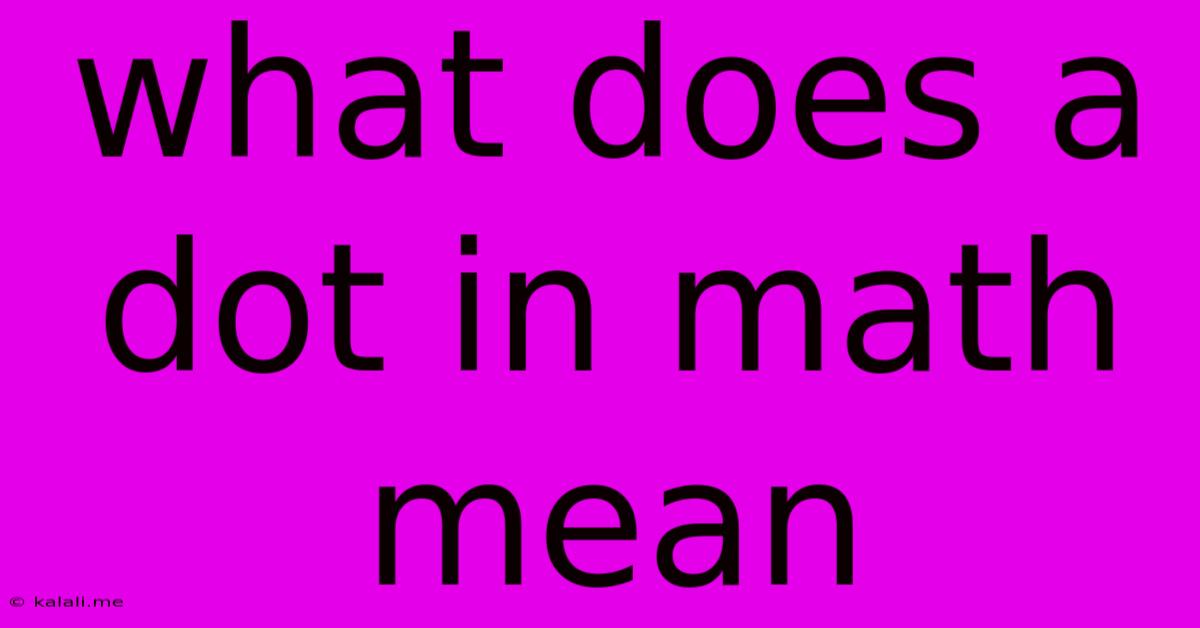What Does A Dot In Math Mean
Kalali
Jun 05, 2025 · 3 min read

Table of Contents
What Does a Dot Mean in Math? Decoding the Mysterious Dot
A simple dot. It seems insignificant, almost invisible. Yet, in the world of mathematics, a dot can hold significant meaning, representing a variety of operations and concepts. Understanding its different uses is crucial for anyone navigating the mathematical landscape, from elementary school students to advanced mathematicians. This article will explore the diverse roles of the dot in mathematical notation.
The meaning of a dot in mathematics heavily depends on its context. It can signify multiplication, decimal points, coordinate points, set notation, and even more nuanced mathematical concepts. Let's break down these key interpretations:
1. Multiplication: The Simple Dot
Perhaps the most common use of a dot in mathematics is to represent multiplication. While the 'x' symbol is frequently used, especially at elementary levels, a dot offers a clearer, less ambiguous representation, particularly when dealing with variables. For instance:
- 3 x 4 can be written as 3 ⋅ 4 or 3 . 4. The dot eliminates any confusion with the variable 'x'.
This is especially useful in algebra where you're working with variables like x and y, and the multiplication symbol 'x' might be mistaken for a variable.
2. Decimal Points: Separating the Whole and the Part
The dot also serves as a decimal point, separating the whole number part from the fractional part of a decimal number. For example:
- 3.14 represents three and fourteen hundredths.
- 25.75 represents twenty-five and seventy-five hundredths.
This is a fundamental concept in representing numbers less than one.
3. Coordinate Points: Locating in Space
In coordinate geometry, a dot represents a point on a graph. These points are defined by their x and y coordinates, often written as (x, y). The dot signifies the precise location of the point on the Cartesian plane. For example:
- (2, 3) represents a point 2 units along the x-axis and 3 units along the y-axis.
Understanding the use of dots in this context is critical for graphing functions and analyzing geometric shapes.
4. Set Notation: Representing Elements
In set theory, a dot can indicate the membership of an element within a set. This is often expressed as:
- x ∈ A which reads as "x is an element of set A". While not explicitly a dot, the symbol ∈, is derived from the Greek letter epsilon and can be visually considered similar.
This notation is fundamental in expressing relationships between elements and sets.
5. Scalar Product (Dot Product): A More Advanced Application
In linear algebra, the dot signifies the dot product (also known as the scalar product) of two vectors. This operation results in a scalar value (a single number) rather than another vector. The calculation involves multiplying corresponding components of the vectors and summing the results.
Beyond the Basics: Context is Key
While the examples above highlight the major uses of dots in mathematical notation, remember that the precise meaning always depends on the mathematical context. Always consider the surrounding symbols and the overall mathematical expression to correctly interpret the function of the dot. Pay attention to the surrounding symbols and the broader mathematical context for accurate interpretation. Careful examination and understanding of the mathematical context are critical for correctly interpreting the meaning of the dot.
By understanding these various applications, you'll be better equipped to navigate mathematical expressions with confidence and accuracy. The humble dot, therefore, plays a much larger role than its simple appearance might suggest.
Latest Posts
Latest Posts
-
What Is Cc On A Motorcycle
Jun 06, 2025
-
How Do You Paint Parking Lot Lines
Jun 06, 2025
-
How To Get Rid Of Crazy Ants
Jun 06, 2025
-
How Can I Keep Dogs Out Of My Yard
Jun 06, 2025
-
3 Speed Fan Switch Wiring Diagram
Jun 06, 2025
Related Post
Thank you for visiting our website which covers about What Does A Dot In Math Mean . We hope the information provided has been useful to you. Feel free to contact us if you have any questions or need further assistance. See you next time and don't miss to bookmark.